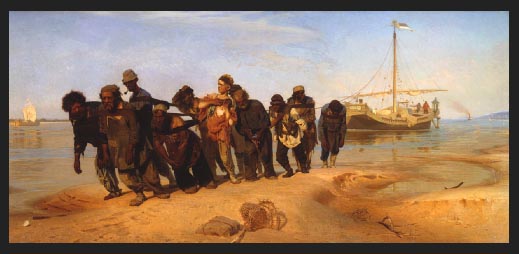
The Seeds of Russia's Cultural Revolution:
The Peredvizhniki (Wanderers)
and The Society for Traveling Art Exhibitions

"Barge-Haulers
on the Volga (The Volga Boatmen)" (1870-73)
Ilya Repin (1844-1930)
"Art is an educational means of colossal force." -Lunacharskii (Perspectives of Soviet Art, 1927)
"Revolutionary literature and art should create a variety of characters out of real life and help the masses to propel history forward. For example, there is suffering from hunger, cold and oppression on the one hand, and exploitation and oppression of man by man on the other. These facts exist everywhere and people look upon them as commonplace. Writers and artists concentrate such everyday phenomena, typify the contradictions and struggles within them and produce works which awaken the masses, fire them with enthusiasm and impel them to unite and struggle to transform their environment." -Mao Tse-tung (Talks at the Yenan forum on Literature and Art.)
The Peredvizhniki (Wanderers or Itinerants) were a group of artists in 19th century Russia who represent the seeds of Russia's Cultural Revolution. Commiting themselves to populist themes in an accesible realist style, the work they produced provided the people of Russia visions of the struggle of the lower economic and working classes (Barge-Haulers on the Volga, (The Volga Boatmen) and Troika (The Threesome)), it showed a celebration of the people of the lower economic classes as well as of people involved in resistance (Woodsman and Boyarina Morozova), and it depicted the deep corruption within authorities and dynastic rule (The Easter Procession and Tsar Ivan IV with the Body of his Son Ivan on November 16, 1581). These visions functioned educational tools to arouse and awaken the masses to the problems of the system they were a part of and helped in changing the value systems of the people of Russia to become primed for revolution. Although they may not have envisioned the revolution to come nor even considered themselves revolutionaries at all, through the subject matter of their work as well as through the way in which they made their work readily available to the masses both physically and stylistically, the Peredvizhniki contributed to changing the public mind state to become more critical of the system within which they lived, creating a desire within the public to create reform and eventually revolutionary systemic change.
The History of the Peredvizhniki and the Formation of the Society for Traveling Art Exhibitions:
The Peredvizhniki:
Vasily Perov (1834-1882)
Ivan Kramskoy (1837-1887)
Ilya Repin (1844-1930)
Vasily Surikov (1848-1916)
Other Members:
Miasoedov, Kamenev,
Savrasov, Amosov, Ammon, M.P. Klodt, M.K. Klodt, Prianishnikov, Shishkin, Bogoliubov,
Gun (Huns), V.E. Makovskii, Maksimov, Briullov, Savitskii, Kuindzhi, Bronnikov,
V.M. Vasnetsov, Litovchenko, Lemokh, N.E. Makovskii, Polenov, Volkov, K.E. Makovskii,
Leman, Nevrev, Kharlamov, Kuznetsov, Bodarevskii, Dubovskoi, A.M. Vasnetsov,
Svetoslavskii, Shil'der, Arkhipov, Levitan, Ostroukhov, Zagorskii, Lebedev,
Stepanov, Pozen, Kasatkin, Miloradovich, Shanks, Serov, Bogdanov-Bel'skii, I.P.
Bogdanov, A. Korin, Endogurov, Nesterov, Baksheev, Orlov, and Kostandi.
References/Peredvizhniki Links:
http://www.bol.ucla.edu/~klenin/indexold.html
http://www.rollins.edu/Foreign_Lang/Russian/front.html
http://www.abcgallery.com/countrind.html#Russia
http://www.dartmouth.edu/~russ15/russia_PI/Russian_art.html
https://www.bol.ucla.edu/~wew/
http://faculty-web.at.nwu.edu/slavic/theater/index.html
http://russian.arizona.edu/russia/artpres/sld006.htm
http://www.ku.edu/~russcult/culture/visual_index/peredvizhniki/
http://www.fleischer.org/impusr.html
http://faculty-web.at.nwu.edu/slavic/theater/index.html
http://faculty.oxy.edu/richmond/Tolstoy/politics_of_the_arts_in_tolstoy.htm
http://www.usc.edu/dept/LAS/IMRC/russianart/nineteenthcentury.HTM
Webmaster: Eric Strand (estrand@ucla.edu).